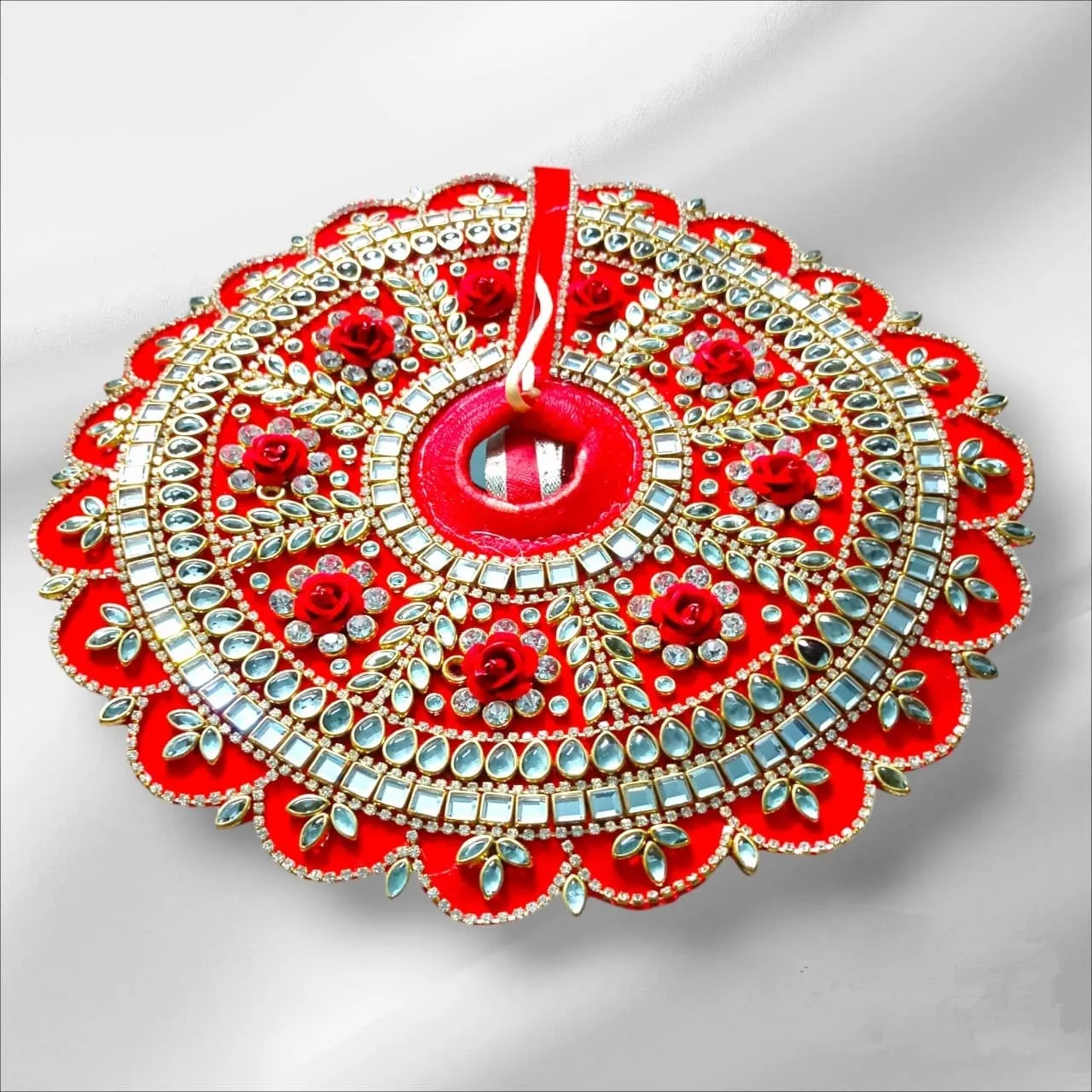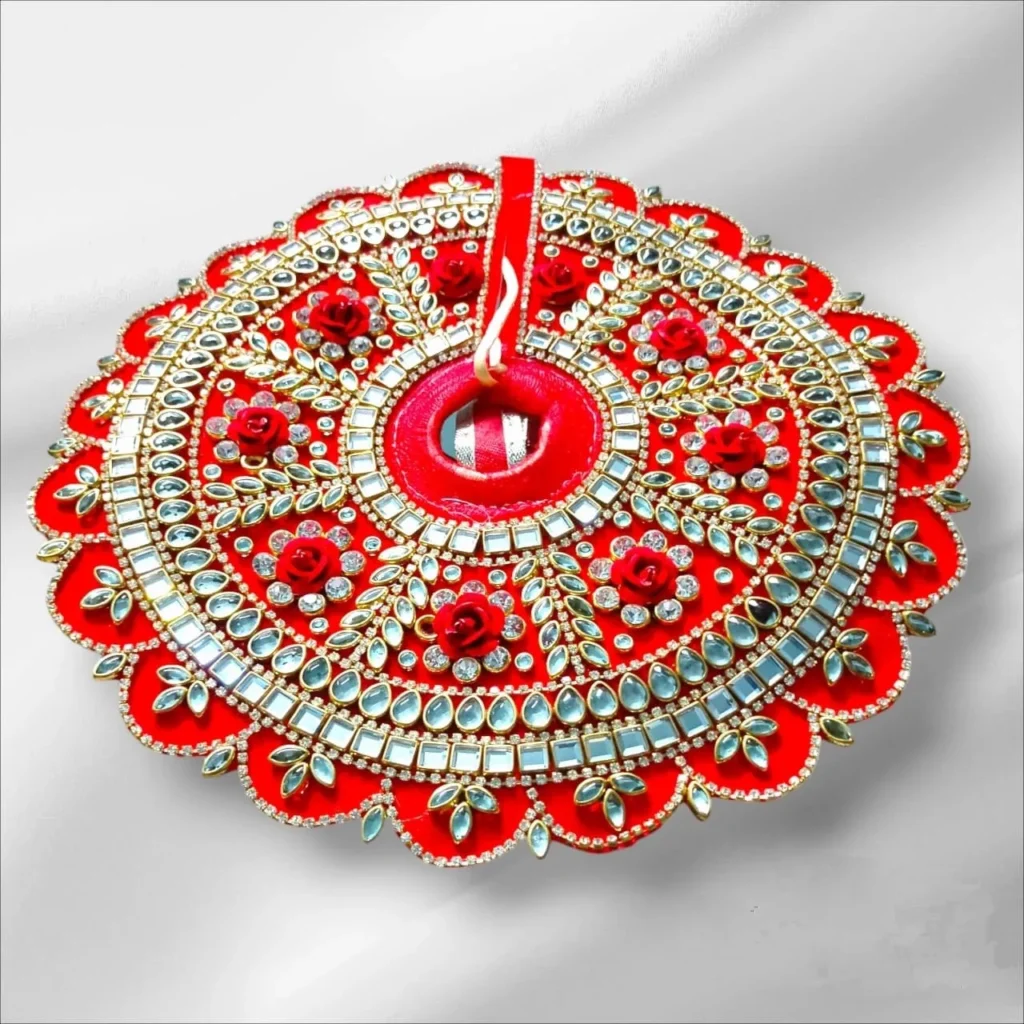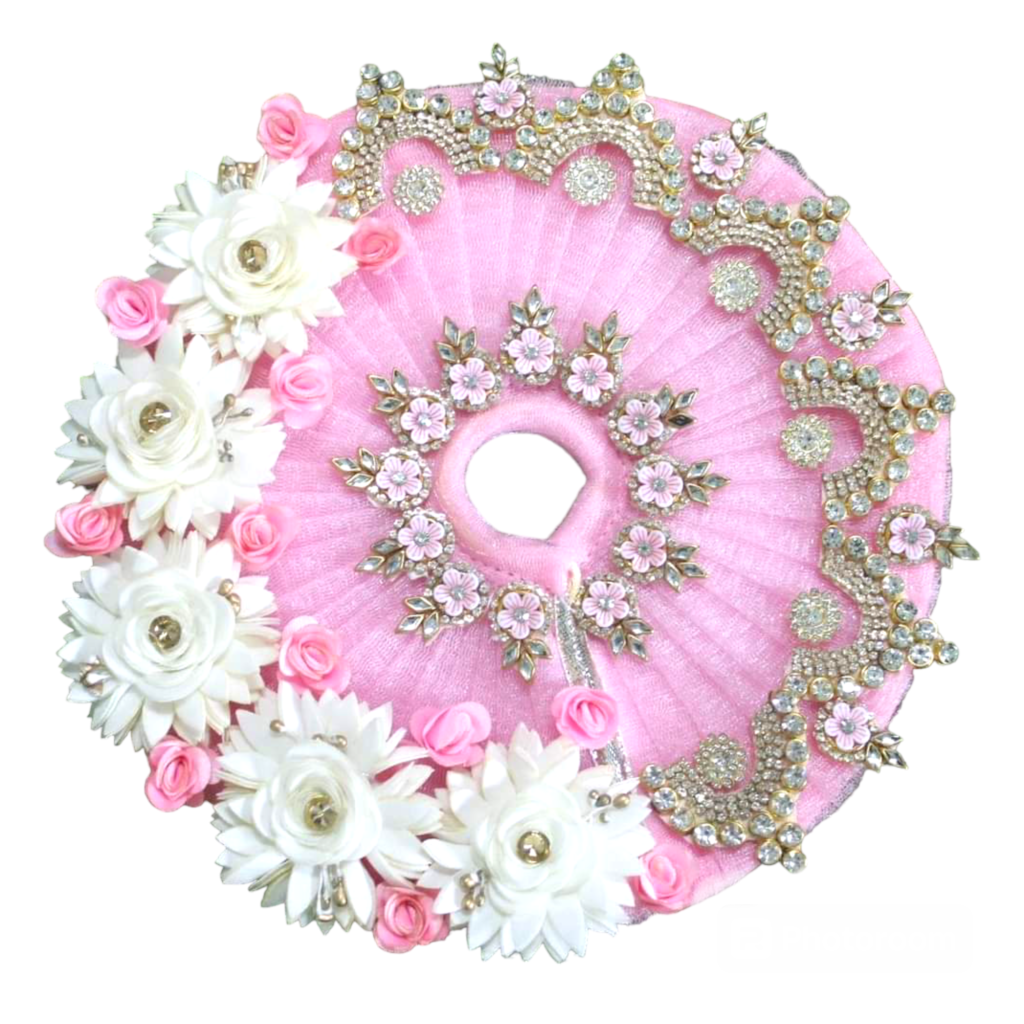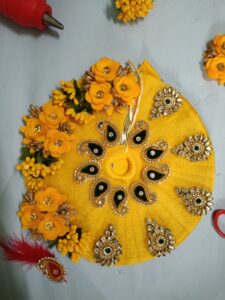
Janmashtami Dress for Laddu Gopal: A Complete Guide in 2024
Introduction: Janmashtami Dress for Laddu Gopal
Overview of Janmashtami
Janmashtami, the joyous festival celebrating the birth of Lord Krishna, is one of the most significant festivals in the Hindu calendar. Observed with fervor and devotion across India and many parts of the world, it marks the divine arrival of Krishna, the eighth avatar of Vishnu, who is revered for his enchanting personality and divine playfulness. Celebrations are characterized by fasting, singing devotional songs, preparing special foods, and reenacting episodes from Krishna’s life.
Importance of Laddu Gopal in Janmashtami
Laddu Gopal, the adorable infant form of Lord Krishna, holds a special place in the hearts of devotees. This representation of Krishna as a child is central to Janmashtami rituals. Devotees decorate their homes and temples with elaborate setups called ‘Jhankis’ to depict scenes from Krishna’s life, with Laddu Gopal taking center stage. Dressing Laddu Gopal in beautiful garments and ornaments is an act of devotion and love, symbolizing the care and affection devotees have for the deity.
Significance of Dressing Laddu Gopal

Dressing Laddu Gopal is more than a ritual; it is a heartfelt tradition that expresses reverence and devotion. Each garment and accessory is chosen with care, reflecting the devotee’s desire to honor and celebrate Krishna. The process of adorning Laddu Gopal is believed to bring divine blessings and foster a deeper spiritual connection. It’s a way for devotees to partake in the divine leelas (plays) of Krishna, immersing themselves in the joy and innocence that Laddu Gopal embodies.
Historical Context
Origins of Janmashtami
Janmashtami’s origins date back thousands of years to ancient India, with references found in the Mahabharata and the Bhagavad Gita. The festival commemorates the birth of Krishna, who was born to Devaki and Vasudeva in the Dvapara Yuga. Despite being born in a prison cell, Krishna’s miraculous escape and eventual rise as a divine figure signify the victory of good over evil.
Evolution of Janmashtami Celebrations
Over centuries, Janmashtami celebrations have evolved, incorporating regional traditions and cultural nuances. From the early temple rituals to grand public celebrations, the festival has expanded in scale and diversity. Each region of India has its unique way of celebrating Janmashtami, with variations in customs, prayers, and festivities, reflecting the rich cultural tapestry of the country.
Historical Significance of Laddu Gopal
Laddu Gopal, representing the child form of Krishna, has been venerated for centuries. Historical texts and scriptures often depict Krishna’s childhood exploits, which are celebrated with great enthusiasm during Janmashtami. The tradition of dressing Laddu Gopal likely originated from these early devotional practices, symbolizing the nurturing and loving aspects of the divine-human relationship.
Understanding Laddu Gopal
Who is Laddu Gopal?
Laddu Gopal, also known as Bal Gopal or Natkhat Gopal, is the infant avatar of Lord Krishna. This form is particularly cherished for its depiction of Krishna’s childhood innocence and playful nature. Devotees often keep Laddu Gopal idols in their homes, engaging in rituals and daily worship that foster a personal and intimate connection with the deity.
Symbolic Importance of Laddu Gopal
Laddu Gopal symbolizes purity, innocence, and divine joy. The idol is often seen holding a laddu (sweet ball), which represents the sweetness of devotion and the divine blessings that Krishna bestows upon his followers. The child form of Krishna reminds devotees of the importance of nurturing innocence and joy in their spiritual practices.
Different Forms and Sizes of Laddu Gopal Idols
Laddu Gopal idols come in various forms and sizes, each catering to different devotional preferences. From small, handheld idols to larger, more elaborate statues, the variety allows devotees to choose an idol that best fits their worship practices. The idols are often made from materials like brass, clay, or marble, each adding a unique aesthetic and spiritual value.
Types of Janmashtami Dresses for Laddu Gopal
Traditional Dresses
Traditional dresses for Laddu Gopal are inspired by classical Indian attire. These include dhotis, kurtas, and angarakhas, often embellished with intricate embroidery and vibrant colors. Traditional outfits reflect the cultural heritage and are usually made from materials like silk, cotton, and brocade.
Modern Dresses

Modern dresses for Laddu Gopal incorporate contemporary designs and fabrics. These may include innovative patterns, trendy colors, and new-age materials like synthetic blends. Modern outfits often blend tradition with contemporary fashion, offering a fresh take on devotional dressing.
Regional Variations
Different regions in India have their unique styles of dressing Laddu Gopal. For example, in Gujarat, the attire might include mirror work and bandhani prints, while in Bengal, the dresses might feature delicate muslin and kantha embroidery. These regional variations highlight the diversity of Indian culture and the widespread devotion to Krishna.
Materials Used in Janmashtami Dresses
Fabrics
Fabrics play a crucial role in the elegance and comfort of Laddu Gopal’s dresses. Common fabrics include silk, cotton, velvet, and brocade. Each fabric has its unique texture and appeal, contributing to the overall aesthetic of the outfit.
Accessories
Accessories enhance the beauty of Laddu Gopal’s attire. These include tiny jewelry pieces like necklaces, bangles, anklets, and belts. Accessories are often adorned with beads, stones, and pearls, adding a touch of luxury and grandeur.
Embellishments
Embellishments such as sequins, beads, embroidery, and lacework are used to decorate Laddu Gopal’s dresses. These elements add richness and intricate detail, making each dress a unique piece of devotional art.
Design Elements
Color Choices
Color plays a significant role in the design of Laddu Gopal’s dresses. Traditional colors like yellow, saffron, red, and blue are popular, each carrying its symbolic meaning. Yellow, for instance, is associated with Krishna’s childhood, while blue represents his divine nature.
Embroidery and Patterns
Embroidery and patterns on Laddu Gopal’s dresses often depict floral designs, paisleys, and other traditional motifs. Hand-embroidered details add a personal touch and enhance the visual appeal of the outfits.
Cultural Motifs
Cultural motifs in Laddu Gopal’s dresses reflect regional artistry and heritage. These motifs might include peacocks, lotus flowers, and other symbols associated with Krishna and Indian culture. Incorporating these motifs connects the devotional practice to a broader cultural context.
How to Choose the Right Dress for Laddu Gopal
Size Considerations
Choosing the right size for Laddu Gopal’s dress is crucial for a proper fit and appearance. Devotees should measure the idol accurately and select outfits that complement the proportions of the statue.
Occasion-Specific Outfits

Different occasions call for different outfits for Laddu Gopal. Festive dresses for Janmashtami are typically more elaborate, while everyday attire might be simpler and more practical. Special occasions like Radha Ashtami or Holi might also inspire unique dressing styles.
Personal Preferences
Personal preferences play a significant role in selecting Laddu Gopal’s attire. Devotees often choose colors, fabrics, and designs that resonate with their aesthetic sensibilities and devotional feelings.
DIY Janmashtami Dress Ideas
Simple DIY Dresses
Creating simple DIY dresses for Laddu Gopal can be a fulfilling devotional activity. Using basic materials like cotton fabric, lace, and beads, devotees can craft beautiful and unique outfits.
Advanced DIY Techniques
For those with sewing skills, advanced DIY techniques can produce intricate and professional-looking dresses. Techniques like embroidery, applique, and beadwork can add elaborate details to the outfits.
Tips for Beginners
Beginners looking to make Laddu Gopal dresses should start with easy patterns and gradually move to more complex designs. Online tutorials, pattern books, and craft kits can provide valuable guidance and inspiration.
Where to Buy Janmashtami Dress for Laddu Gopal
Local Markets
Local markets in India are treasure troves of traditional and modern Laddu Gopal dresses. These markets offer a wide variety of outfits, often handmade and reflecting local craftsmanship.
Online Stores
Online stores provide a convenient way to purchase Laddu Gopal dresses. Websites like Amazon, Flipkart, and specialized devotional sites offer extensive collections, ranging from simple to elaborate designs. www.laddugopaldress.in is the best place to buy laddu gopal dress.
Custom Dress Makers
For a unique and personalized touch, custom dress makers can create bespoke outfits for Laddu Gopal. These artisans work closely with devotees to design dresses that meet specific preferences and requirements. www.laddugopaldress.in also provides customized options.
Dressing Rituals
Preparing Laddu Gopal for Dressing
Preparing Laddu Gopal for dressing involves cleansing the idol with water and milk, followed by drying it carefully. This ritualistic cleansing is essential to ensure purity before adorning the deity.
Dressing Techniques
Dressing Laddu Gopal requires a delicate touch and reverence. Devotees often follow traditional methods, starting with the inner garments and gradually adding outer layers and accessories.
Adorning with Accessories
Adding accessories like jewelry, crowns, and footwear completes the dressing ritual. Each accessory is placed with devotion, enhancing the overall appearance of Laddu Gopal.
Accessories for Laddu Gopal
Jewelry
Jewelry for Laddu Gopal includes tiny necklaces, earrings, bangles, and rings. These pieces are often made from gold, silver, or colorful beads, adding a regal touch to the deity’s attire.
Crowns and Headgear
Crowns and headgear are iconic accessories for Laddu Gopal. These include mukuts (crowns) decorated with peacock feathers, stones, and pearls, symbolizing Krishna’s royal and divine status.
Footwear
Tiny footwear like padukas (wooden sandals) and mojris (traditional shoes) are sometimes used to complete Laddu Gopal’s ensemble. These pieces are often intricately designed to match the outfit.
Popular Trends in Laddu Gopal Dresses
Current Trends
Current trends in Laddu Gopal dresses include fusion styles that blend traditional and modern elements. Popular designs often feature bright colors, innovative patterns, and a mix of fabrics.
Influences from Bollywood and TV Shows
Bollywood movies and TV shows depicting Krishna’s life have a significant influence on Laddu Gopal’s fashion. Outfits inspired by these portrayals often become popular among devotees.
Celebrity-Inspired Outfits
Outfits inspired by celebrities who play or venerate Krishna also set trends. These designs often reflect the opulence and grandeur seen in celebrity wardrobes, adapted for Laddu Gopal.
Maintenance of Laddu Gopal Dresses
Cleaning Tips
Maintaining the cleanliness of Laddu Gopal’s dresses is essential. Gentle hand washing with mild detergents is recommended for most fabrics. Embellished dresses may require special care, such as dry cleaning.
Storage Solutions
Proper storage of Laddu Gopal’s dresses ensures their longevity. Dresses should be stored in a cool, dry place, preferably in fabric bags to prevent damage from dust and insects.
Repairing Damaged Dresses
Repairing damaged dresses involves careful stitching and replacing missing embellishments. Keeping a basic sewing kit handy can help devotees fix minor issues and maintain the dresses in good condition.
Frequently Asked Questions (FAQs)
Common Queries About Laddu Gopal Dresses
Common questions include how to measure the idol for dresses, where to find specific types of outfits, and the significance of certain colors and designs.
Tips for First-Time Buyers
First-time buyers should consider the size of their idol, the occasion, and their personal preferences. It’s also helpful to start with simpler designs before exploring more elaborate options.
How to Maintain the Beauty of Laddu Gopal Outfits
To maintain the beauty of Laddu Gopal’s outfits, regular cleaning, careful storage, and prompt repairs are essential. Avoid exposing the dresses to direct sunlight and moisture to prevent fading and damage.
Expert Insights
Interviews with Designers
Designers specializing in Laddu Gopal dresses share insights into the latest trends, popular materials, and the creative process behind their designs.
Opinions from Devotees
Devotees provide valuable perspectives on the spiritual and emotional significance of dressing Laddu Gopal. Their experiences highlight the deep connection between the devotee and the deity.
Tips from Seasoned Practitioners
Seasoned practitioners offer practical tips on selecting, maintaining, and adorning Laddu Gopal dresses, drawing from years of experience and devotion.
Personal Stories and Experiences
Testimonials from Devotees
Testimonials from devotees reveal the joy and fulfillment derived from dressing Laddu Gopal. These personal stories often reflect the deep emotional and spiritual bond with the deity.
Unique Dressing Experiences
Unique dressing experiences, such as themed outfits or collaborative dressing sessions, showcase the creativity and community spirit among devotees.
Community Celebrations
Community celebrations during Janmashtami often involve the collective dressing of Laddu Gopal idols, fostering a sense of unity and shared devotion among participants.
Conclusion
Recap of Key Points of Janmashtami Dress for Laddu Gopal
The tradition of dressing Laddu Gopal is a beautiful expression of devotion that combines cultural heritage, personal creativity, and spiritual reverence. From understanding the significance of Laddu Gopal to exploring various types of dresses, materials, and accessories, this guide provides comprehensive insights into this cherished practice.
Final Thoughts on the Significance of Dressing Laddu Gopal
Dressing Laddu Gopal is a meaningful ritual that enhances the spiritual experience of Janmashtami and daily worship. It allows devotees to connect deeply with Krishna, celebrating his divine presence with love and care. Through thoughtful selection and creative expression, each dress becomes a symbol of devotion, enriching the spiritual journey of every devotee.

